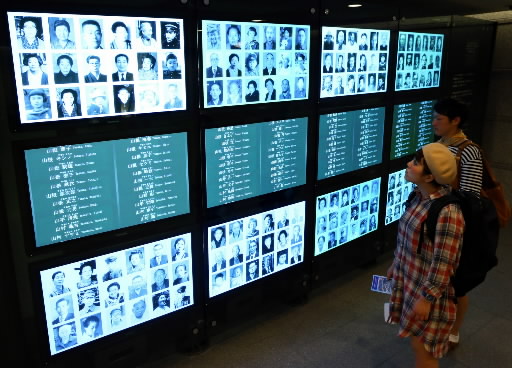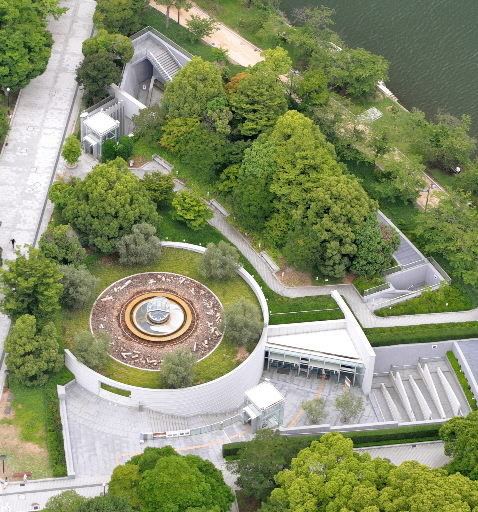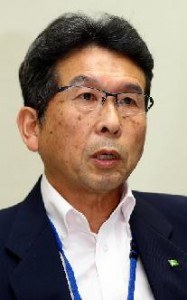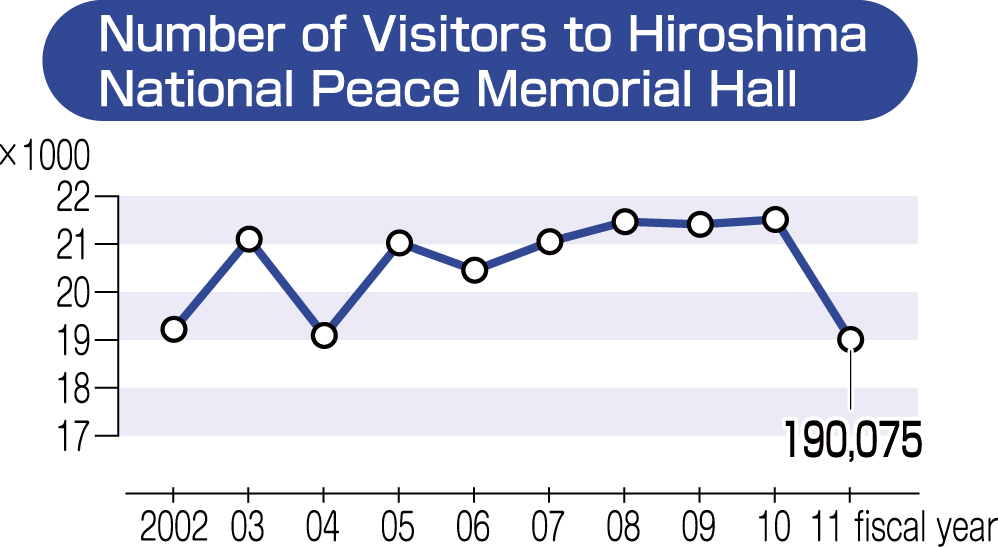Peace Memorial Hall for the A-bomb Victims marks its 10th anniversary
Jul. 2, 2012
Greater use must be made of A-bomb survivors’ accounts
by Tomomitsu Miyazaki, Senior Staff Writer
Hiroshima National Peace Memorial Hall for the Atomic Bomb Victims, located in Peace Memorial Park, will mark the 10th anniversary of its opening on August 1. Though it has a lower profile and a smaller number of visitors when compared to Hiroshima Peace Memorial Museum, which stands just to the south, the hall has steadily strengthened its appeal that “the horror of nuclear weapons must never be seen again” through the accounts written by A-bomb survivors and photographs of the A-bomb victims. With the A-bomb survivors growing older, gathering their testimonies has become an urgent task. The hall also faces the challenge of how the A-bomb accounts are used, such as in readings for the public or for study and analysis.
Peace Memorial Hall is located east of the Cenotaph for the A-bomb Victims. The building, constructed beneath the ground, includes the Hall of Remembrance for mourning the dead, a library which houses the accounts of A-bomb survivors, and an information area with photographs of the victims. Roughly 200,000 people visit the hall annually, a number equivalent to roughly 16 percent of entries to Peace Memorial Museum.
The functions of Peace Memorial Hall are significant, however. One of the hall’s roles involves collecting the testimonies of A-bomb survivors. By the year 2002, when the hall was established, nearly 100,000 A-bomb accounts had already been collected through calls made by the Japanese government and other entities. Since then, the number has grown, year after year. In 2006, the hall initiated an effort in which “writing assistants” help A-bomb survivors record their experiences when the survivors are unable to write due to illness or other reasons. Each year, about 10 A-bomb survivors have been aided in this way.
Making use of A-bomb accounts remains a large challenge
One unique program administered by Peace Memorial Hall involves readings of A-bomb accounts for the public. With the help of volunteers, the hall has been holding readings for students on school trips and other listeners. The number of readings each year has risen to about 180. Students taking part in these sessions are also asked to read some of the accounts aloud to provide them with opportunities to hear the voices of the survivors and victims “directly.” With the number of A-bomb survivors able to personally share their accounts on a steady decline, the significance of the program has grown.
Peace Memorial Museum seeks to convey the consequences of the atomic bombing through artifacts, such as mementos and photographs of the A-bomb victims. In comparison, Peace Memorial Hall makes its appeal through the words of the A-bomb survivors and victims: how the atomic bombing has affected their physical health, taxed their mental health, stolen away family members and loved ones, and destroyed their communities.
In a sense, while the museum relates the devastating power of the atomic bomb, the hall expresses the horror of the bombing from the perspective of individuals. A full picture of the atomic bombing can thus be gained by visiting both facilities.
To make greater use of the A-bomb accounts, they should be translated into a variety of languages. In this way, the testimonies can serve as voices from the A-bombed city and be transmitted to the world at large.
Peace Memorial Hall was constructed by the Japanese government, under the provisions of the Atomic Bomb Survivors’ Relief Law. The Hiroshima Peace Culture Foundation has been commissioned by the Japanese government to run the facility. At the same time, it is vital that the Hiroshima city government, the Hiroshima prefectural government, and Japan’s central government offer proactive support to the hall so that greater use can be made of the A-bomb testimonies and sufficient human resources are available for the hall’s efforts.
Interview with Shinji Asakawa, director of Peace Memorial Hall
Conveying the voices of survivors and victims to younger generations
The Chugoku Shimbun interviewed Shinji Asakawa, 63, director of Peace Memorial Hall, on the current state of the facility, and its challenges for the future, as it now marks its 10th anniversary.
What are your thoughts on the activities of the hall over the past 10 years?
The hall still has a low profile, so it’s true that more effort must be made from the standpoint of public relations. When people visit here, though, they are able to spend an unhurried time reading accounts of A-bomb survivors and listening to readings of the testimonies, enabling them to hear the voices of the A-bomb survivors and victims “directly.” When I read the essays of students who came to the hall on school trips, it’s clear to me that they have been affected by the voices of the survivors, who suffered a hellish experience. I believe that our appeal for the abolition of nuclear weapons, as well as the idea of cherishing the preciousness of peace, has reached them.
The number of visitors to Peace Memorial Hall stands at only one-sixth of the figure for Peace Memorial Museum. Do you have any ideas to remedy that?
Although the nature of the hall is different from that of the museum, which is focused on artifacts of the bombing, such as mementos of the victims, both the hall and the museum hold the same grave mission. I would like for the hall and the museum to strengthen their sense of collaboration so that visitors to the museum will also come to the hall.
For instance, I would like to see many students on school trips taking part in the readings of the A-bomb accounts that are held at the hall. To achieve this aim, I will work on making the reading of A-bomb accounts and these reading sessions held in the hall an important part of peace education.
I imagine that making use of the A-bomb accounts, along with collecting new testimonies, are challenges for the hall.
I would like to see greater use made of the A-bomb accounts. For example, when accounts are added to the hall’s computer system, visitors can read them on monitors and search them freely with key words. This will support further research and analysis of the testimonies. Nurturing the human resources to conduct such studies is also important.
Of course, collecting more accounts is also crucial, as the window of opportunity is closing. With A-bomb survivors growing older, our time is limited. I hope to increase the number of testimonies by making appeals to the public.
Profile
Shinji Asakawa
Mr. Asakawa became a public servant for the City of Hiroshima in 1973. After serving in such positions as a staff member of the Public Relations Division, the director of the Asakita Ward Citizens Affairs Bureau, and the secretary general of the Hiroshima City A-bomb Survivors Council, Mr. Asakawa took office as the third director of Hiroshima National Peace Memorial Hall for the Atomic Bomb Victims in April 2012.
Hiroshima National Peace Memorial Hall for the Atomic Bomb Victims
(As of March 31, 2012, except as noted)
Total visitors: 2,106,321 (as of June 30, 2012); 589 visitors per day
A-bomb accounts collected: 132,971 accounts are available to the public. Among this number, 121,205 are contained in a database. 434 accounts can be read on computer monitors.
Registered photos of A-bomb victims: 15,815 photos (including those not available to the public)
A-bomb survivors aided in writing testimonies: 71 people (The program began in fiscal 2006.)
Readings of A-bomb accounts: 1,351 sessions have been held with 109,751 participants. About 90 people serve as reading volunteers.
Accounts translated into other languages: Accounts have been translated into 16 languages (English, Chinese, Korean, French, Spanish, Italian, Portuguese, German, Russian, Thai, Indonesian, Filipino, Malay, Arabic, Urdu and Hindi)
Videos of A-bomb accounts: 268
(Originally published on July 16, 2012)











